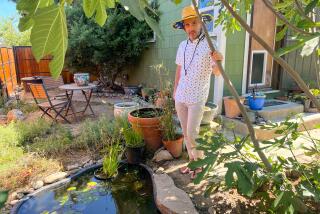Spectacular Spikes and Spires Will Add Color and Drama
- Share via
Gardens without flowers are somehow not really gardens. A British friend of mine living in Culver City considered her backyard the “garden,” when in fact it consisted of a pleasant, if somewhat straggly, grass lawn with a few trees and bushes. Not a flower in sight.
To me, a garden means flowers--carefully selected, aesthetically arranged, lovingly cultivated and dramatically displayed.
Although my spring display seldom fulfills my fantasies, I have learned, primarily from trial and error, some valuable lessons about planning the flower garden, and one of the most important is the need for contrasting heights.
A garden composed of endless mounds of plants about the same height is dull and insipid, no matter how striking the individual flowers. A pleasing garden combines round shapes with vertical accents, usually in the form of spikes, spires and columns.
Artful Blends
The splendid English borders, often pictured in American gardening books, yet rarely duplicated here, artfully blend mounds of such flowers as asters, daisies and bellflowers with spikes of lupines, mullein . . . lavender.
What are the best plants for vertical accents in Southland borders?
A favorite of seasoned gardeners is salvia farinacea, the blue perennial sage that is usually treated as an annual. Small seedlings from the nursery can be planted almost any time from fall through late spring, and the results are sensational. The deep blue spires complement all colors in the garden, but they are particularly fetching with yellow or orange calendulas, pink or red dianthus or velvety red annual phlox. Although seed catalogues promise 18-inch spikes, blue salvias in my garden often climb to two or three feet.
For stately vertical lines in the garden, surely nothing is more elegant than regal delphiniums, and Descanso Gardens in La Canada unquestionably produces some of the finest delphiniums grown outside of England.
George Lewis, Descanso’s superintendent and master gardener, outlines a careful regimen of cultivation, starting in the fall with sturdy leafy seedlings planted in three-inch pots filled with enriched soil. After three or four weeks, the seedlings are transplanted to four-inch pots, and all the while they are fed with a balanced liquid fertilizer.
(Most people start by buying the plants in four-inch pots, rather than starting with seedlings. They can be planted in the yard at any time.)
In January or February, Lewis moves his plants into the ground, which has been dug deeply with well-rotted manure and compost. Immediately, each small delphinium plant gets a six-foot wooden stake that looks overpowering and unnecessary at first but proves to be essential when the heavy flower stems develop in late spring.
The secret to magnificent delphiniums, Lewis says, is heavy, heavy feeding. Because they are such greedy feeders, delphiniums need constant nourishment in the form of rich soil, a shot of blood meal at planting time and regular liquid fertilizer applied to the foliage and roots as they grow.
But are delphiniums worth all the fuss and bother?
Much less demanding, far more profuse, and much longer blooming are larkspur, the country cousins of delphiniums. Larkspurs are annuals and grow easily from seed planted in the fall or early spring. It’s even easier, though, to plant nursery seedlings, which usually become available in February.
Because the slender stems can’t support their many flowers, larkspurs usually require stakes.
How to Achieve Height
Foxgloves are an additional means of achieving height in Southland gardens. These three- to five-foot hybrids produce spires of marvelously speckled tubular florets in pink, salmon, cream and rose.
Foxglove seedlings may be planted in the fall or early spring. Although they are biennials and usually take two years to bloom, the hybrid Foxy will bloom in just five months from seed.
You’ll probably be very disappointed with your foxgloves if you wait until late spring to plant them. They need at least four months of cool weather to develop healthy root systems.
Another good choice for garden height is the snapdragon, a dependable cool-climate performer. The tall varieties reach three or four feet, while mid-size bushes top out at 20 inches. In my own garden, though, I’ve stopped growing snapdragons, because I won’t spray them every week or so to prevent rust.
Before setting out any of the flowers described here, be sure to prepare the soil thoroughly by digging it at least eight inches deep and incorporating soil amendments such as redwood compost.






